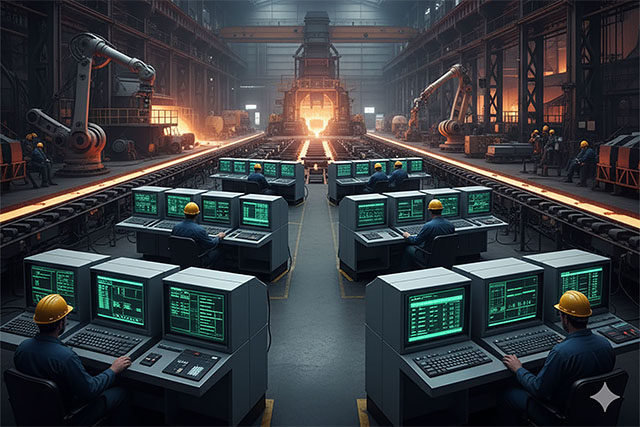Talk: Radical adoption of computer technology at Llanwern steelworks, South Wales – an object lesson for AI [Newcomen Society]
- Tue 25 Nov 2025
- 6:30 pm
- Free

Why do some automation projects succeed, while others fail? More broadly, how do organisations shape new technology – for good or ill? Why are some automation schemes supported and some resisted, subverted and discarded?
Here we document one historical example. Expect many photos of solid engineering, beehive hairdos and a walk-on part for Steven Spielberg’s dad.
Two pioneering applications of computers at Llanwern steelworks allow us to compare simultaneous adoption of parallel automation schemes. One succeeded, one failed. The two automation systems were implemented by the same team in the same location for use by the same workforce. Natural experiments such as this are one way to test theory.
By way of explanation we focus on a distinction between “physical technologies” and “social technologies”. The distinction is captured by innovation scholar Dick Nelson’s metaphor of The Moon and the Ghetto. Moonshots required technical solutions. The ghetto was an intractable, multi-dimensional wicked problem. Our experiment suggests it is harder to develop organisational routines for “social technologies” than for “physical technologies”.
The application of a GE 412 to process control of the new wide hot strip mill at Llanwern steelworks in the mid-1960’s in South Wales was precisely specified, technically successful and imitated worldwide. This essentially technical implementation was a “physical technology”. Use of three Elliott 803 computers for managerial tasks of information handling and order scheduling for the same mill was problematic. These management computers were essentially a “social technology.” Computers were far more readily integrated into routines for physical control of a rolling mill, than into the managerial task of scheduling. The research draws on interviews with those who participated in the schemes and private archive sources such as the surviving software.
A Newcomen Society talk.
About the speaker
Jonathan Aylen is an academic researcher who now specialises in the history of technology. He has written on the development of computer guidance systems for Cold War missiles, the development of the first British atomic bomb and on computer control in the steel industry. His approach is to integrate oral history with unorthodox archive sources. Jonathan’s first exposure to computing was writing FORTRAN programmes for an ICL mainframe to support his research in economics.
Jonathan is a recent past President of the Newcomen society for the History of Engineering and Technology and his research output across a range of disciplines can be found here.


